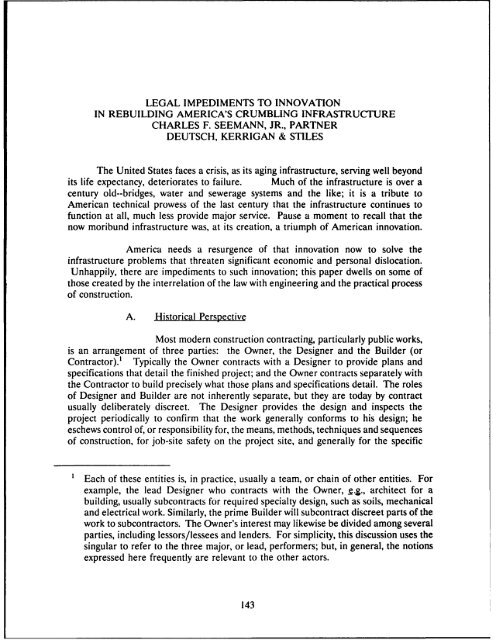Challenges and Opportunities for Innovation in the Public Works ...
Challenges and Opportunities for Innovation in the Public Works ...
Challenges and Opportunities for Innovation in the Public Works ...
Create successful ePaper yourself
Turn your PDF publications into a flip-book with our unique Google optimized e-Paper software.
LEGAL IMPEDIMENTS TO INNOVATION<br />
IN REBUILDING AMERICA'S CRUMBLING INFRASTRUCTURE<br />
CHARLES F. SEEMANN, JR., PARTNER<br />
DEUTSCH, KERRIGAN & STILES<br />
The United States faces a crisis, as its ag<strong>in</strong>g <strong>in</strong>frastructure, serv<strong>in</strong>g well beyond<br />
its life expectancy, deteriorates to failure. Much of <strong>the</strong> <strong>in</strong>frastructure is over a<br />
century old--bridges, water <strong>and</strong> sewerage systems <strong>and</strong> <strong>the</strong> like; it is a tribute to<br />
American technical prowess of <strong>the</strong> last century that <strong>the</strong> <strong>in</strong>frastructure cont<strong>in</strong>ues to<br />
function at all, much less provide major service. Pause a moment to recall that <strong>the</strong><br />
now moribund <strong>in</strong>frastructure was, at its creation, a triumph of American <strong>in</strong>novation.<br />
America needs a resurgence of that <strong>in</strong>novation now to solve <strong>the</strong><br />
<strong>in</strong>frastructure problems that threaten significant economic <strong>and</strong> personal dislocation.<br />
Unhappily, <strong>the</strong>re are impediments to such <strong>in</strong>novation; this paper dwells on some of<br />
those created by <strong>the</strong> <strong>in</strong>terrelation of <strong>the</strong> law with eng<strong>in</strong>eer<strong>in</strong>g <strong>and</strong> <strong>the</strong> practical process<br />
of construction.<br />
A. Historical Perspective<br />
Most modern construction contract<strong>in</strong>g, particularly public works,<br />
is an arrangement of three parties: <strong>the</strong> Owner, <strong>the</strong> Designer <strong>and</strong> <strong>the</strong> Builder (or<br />
Contractor).' Typically <strong>the</strong> Owner contracts with a Designer to provide plans <strong>and</strong><br />
specifications that detail <strong>the</strong> f<strong>in</strong>ished project; <strong>and</strong> <strong>the</strong> Owner contracts separately with<br />
<strong>the</strong> Contractor to build precisely what those plans <strong>and</strong> specifications detail. The roles<br />
of Designer <strong>and</strong> Builder are not <strong>in</strong>herently separate, but <strong>the</strong>y are today by contract<br />
usually deliberately discreet. The Designer provides <strong>the</strong> design <strong>and</strong> <strong>in</strong>spects <strong>the</strong><br />
project periodically to confirm that <strong>the</strong> work generally con<strong>for</strong>ms to his design; he<br />
eschews control of, or responsibility <strong>for</strong>, <strong>the</strong> means, methods, techniques <strong>and</strong> sequences<br />
of construction, <strong>for</strong> job-site safety on <strong>the</strong> project site, <strong>and</strong> generally <strong>for</strong> <strong>the</strong> specific<br />
Each of <strong>the</strong>se entities is, <strong>in</strong> practice, usually a team, or cha<strong>in</strong> of o<strong>the</strong>r entities. For<br />
example, <strong>the</strong> lead Designer who contracts with <strong>the</strong> Owner, e..g., architect <strong>for</strong> a<br />
build<strong>in</strong>g, usually subcontracts <strong>for</strong> required specialty design, such as soils, mechanical<br />
<strong>and</strong> electrical work. Similarly, <strong>the</strong> prime Builder will subcontract discreet parts of <strong>the</strong><br />
work to subcontractors. The Owner's <strong>in</strong>terest may likewise be divided among several<br />
parties, <strong>in</strong>clud<strong>in</strong>g lessors/lessees <strong>and</strong> lenders. For simplicity, this discussion uses <strong>the</strong><br />
s<strong>in</strong>gular to refer to <strong>the</strong> three major, or lead, per<strong>for</strong>mers; but, <strong>in</strong> general, <strong>the</strong> notions<br />
expressed here frequently are relevant to <strong>the</strong> o<strong>the</strong>r actors.<br />
143







